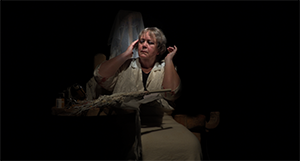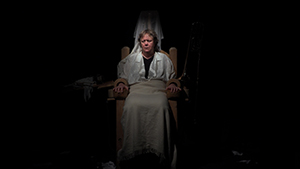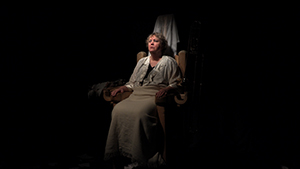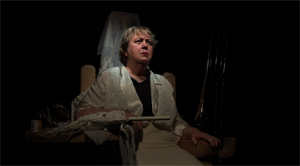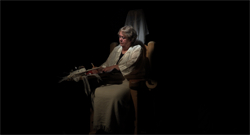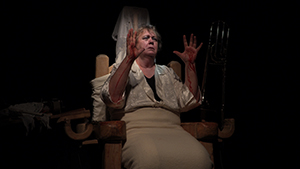|
Our Theories of Chamber Music Theater by William Osborne, April 26, 2011
Introduction
Itís
probably no exaggeration to say that only those who have attempted to write
chamber music theater understand how difficult it is. It is virtually
impossible to combine words and music into theater in a way that isnít
hokey and clunky. And it is even more difficult if the goal is to give
the words, music, and theater an equal artistic value in the service of
substantial characters that develop. It should also be noted that
these difficulties are vastly compounded if everything is in a raw, exposed
chamber music format without the trappings of opera to pad the work with
lavish sets, deafening bel canto voices, massive orchestras, and cavernous
houses.
In
spite of these difficulties, our goal is to make our performances so
natural, and the compositions so effective, that they seem to border on the
effortless. In some cases, this can be a bit misleading. In this
article, we will give you a look behind the scenes and outline some of the
theoretical concepts of music, theater, and performance involved in the
creation of our work. We hope this will help people better understand why chamber music theater is so difficult to create,
and why it is virtually non-existent in the oeuvre of Western classical
music. You can then view (or review) our videos to judge for yourselves
how well we have realized our theoretical concepts.
It
is also important to know that we have been involved in this work for a very
long time. Winne, for example, was completed in 1983.
As time allows, we will be creating and videos of our other
chamber
music theater workssso those interested can
see how our efforts have evolved.so those interested can
see how our efforts have evolved.
The filming process is very complex, and we continue to learn how to make
better videos. As time allows, we will also create better videos of
works we have already filmed. We will also be adding technical
essays about our methods of creating texts, about composing the works,,about videoing them,,and
about the sorts of performance practices we have had to develop.and
about the sorts of performance practices we have had to develop.
The
Missing Genre
These
ideals about small formats and the integration of music theaterís elements
were first outlined by the
Florentine
Camera which flourished from 1577
to 1582. Early developments in opera were soon diverted away from
chamber music theater toward large scale productions with elaborate staging
featuring the bel canto voice accompanied by sizable orchestras. Since
the bel canto voice is poorly suited to delivering texts that can be
understood, the chances of opera genuinely integrating music, text, and
theater were greatly reduced. And the focus on spectacle often
precluded more subtle theatrical exploration. The goal of genuinely
integrating music and theater in small formats was lost. Subsequent
efforts in the following centuries were considered unsuccessful. Among
the most notable were the melodramas off
Romantics like Schumann, Schubert,
and Liszt. The music was often remarkable and inventive, but there
seemed to be a lack of theatrical theory that could provide a basis for the
creation of effective, small-format music theater. (To listen to a
recording of Schumannís melodrama "Die FlŁchtlinge", Op. 122,
Nr. 2 performed by Dietrich Fischer-Dieskau click here.)
The
absence of music theater in chamber formats represents an enormous gap in
the oeuvre of Western classical music. Filling it is a fascinating
challenge that remains to be solved. One reason this has not been done
is that the capacity to create music theater of any sort is one of the
rarest of all human abilities. In the 500 years since the Florentine
Camerata first formulated our concepts of music theater, there have only
been about 10 or 15 composers whose operas are regularly performed.
For chamber music theater, the number is zero. Nevertheless, this
dismal situation might soon change. Developments in technology and
advances in the theory of theater since the Second World War seem to offer
exciting new possibilities for the creation of an effective genre of chamber
music theater.
The
Development of New Theories of Small Theater
One
of the most important of these developments was the appearance of a group of
playwrights who dedicated their careers to works suitable for small theaters
with limited resources and a limited number of actors. Important among
these playwrights were a group of post-war writers based mostly in Paris
that included Samuel Beckett, Harold Pinter, Eugene Ionesco, Jean Genet,
Jean-Paul Sartre, and Antonin Artaud. (Pinter, of course, was
based in London, and Artaud worked mostly before the war.) Their work
established new forms of theatrical theory, but their writings and plays do
not seem to have been widely explored by composers or librettists.
This is unfortunate, since the concepts of these playwrights could be very
useful for the creation of music theater in small formats.
This
is nowhere more apparent than in the work of Samuel Beckett, who late in his
life wrote a series of miniature plays such as Rockaby
and Ohio Impromptu that he felt were literally analogous
to chamber music. His texts are also extremely musical, and as a
director he demanded that they be delivered with musical precision, almost
as if he were directing a musical score. One of his most important
interpreters, the actress Billie Whitelaw, once observed when performing his
short play Footfalls: "I felt
like a moving, musical Edvard Munch painting and, in fact, when Beckett was
directing Footfalls he was not only using me to play the notes, I almost
felt that he did have the paintbrush out and was painting."
In
recent decades smaller works have become more frequent, but as with efforts
during the 19th century, they seem to fail due to the inability
of most composers to apply effective theatrical theories to small-scale
forms of music theater. From the most critical viewpoint,
conceptualism often seemed to become the resort of ignorance and inability
in many of these works. This was a general problem that plagued many artists
in the post-war era, because so many common practices and belief systems
were completely shattered. There were few accepted technical or
aesthetic theories at hand, and those that were in the process of being
formulated, as with the aforementioned playwrights, were difficult to
recognize in the atmosphere of doubt that characterized the period.
In
our attempts to solve some of these problems, my wife and I began by
spending seven years studying the plays of Samuel Beckett and performing
chamber music theater works we created based on them. The musicality
and theatrical precision of Beckettís plays were perfectly suited to this
endeavor. The small format of our works allowed us to put music
theater in a test tube, as it were, and carefully explore and try-out what
worked and what didnít. Miriam, Part I, The
Chair was the first music theater work we wrote after
those many years of involvement with the plays of Beckett, and the theories
of his work are everywhere apparent in it.
A
Different Type of Vocal Production
One
of the first things we learned is that the bel canto voice is often poorly
suited to integrating music, text, and theater because it can make words
difficult to understand. It can also hinder the forms of vocal
inflection that fully integrated acting demands.
The
bel canto voice is extremely beautiful and can reflect profound humanity and
emotional depths, but it can also have a warbling, horsey, egoistic,
physicality that subsumes all other elements of theater. Even in opera,
the elephantine character of the bel canto voice sometimes borders on the
ridiculous. The bel canto voice can be applied to some forms of
chamber music theater, but in some cases, it requires that the singer adapt
his or her forms of vocal production.
We
found that the basic vocal techniques of bel canto applied to a more natural
vocal style were essential to creating the types of integration between words
and music for which we were searching. Among the things you will
notice in the videos are:
An
especially important characteristic of the form of singing we developed is
that it allows for seamless movement between singing and speaking. We
found that being able to use both sung and spoken passages allowed for much
more dimension in our works. The wider pallet of inflection
allowed by a lighter voice increases the ability to create believable acting
and the authentic portrayal of characters. And of course, we do not
present these ideas merely as a concepts or theories. We offer
videos so that people can see the
practical application of our theories and how they work.
The
Importance of Texts
These
negative views of the librettistís art are somewhat one-sided. Even
though librettos all too often fell to hack work, their importance is
demonstrated in most of the truly great operas. Boitoís adaptations
for Verdiís Othello and Falstaff are well-known examples. Other
important examples are the librettos of Da Ponte which so deftly provided a
framework for Mozartís genius. It is impossible to write truly great
operas without excellent librettos.
The
dearth of librettists during the 20th century thus had
catastrophic consequences. More operas probably failed due to bad
librettos than to poor composition. Another result was that the art of
writing librettos did not continue to evolve. The few librettists that
remained continued to think of opera in terms of 19th century
practices, and failed to keep pace with the 20th centuryís
newly evolving theories of theater. Many recent operas are so locked
in slightly updated 19th century conceits that they hardly even
reach the early 20th century theoretical concepts behind the
comedies of Oscar Wilde or the social realism of Berthold Brecht. Some
librettists have employed the seemingly modern techniques of minimalism, but
still in service of spectacles reminiscent of 19th century
theatrical values. There have also been attempts to revive opera by
embracing exoticism, such as the use of Chinese instruments and myths.
Here too the efforts are superficial, have a 19th century
quality, and do not provide long-term solutions or the basic understanding
of current theatrical theory that is needed if classical music is to keep
the development of music theater alive.
Perhaps
it is worth noting that one off-shoot of this problem with librettos has
been the development Regietheater. In essence, it exists because many,
if not most opera librettos are so absurd that they beg for enhancement.
Sadly, this seems to apply to many contemporary operas as well.
Unfortunately, Regietheater is a stop-gap method of trying to improve
librettos (both new and old.) And even more, itís a largely futile
attempt to recreate texts in ways that might give the standard repertoire
more theatrical substance and modern relevancy.
Stage
Directions As An Integral Part of Scores
In
addition to giving our texts a weight equal to the music, we also place a
special emphasis on stage directions and actions, and precisely notate them
in our scores. Through our study of Beckett, we developed the theoretical
concept that a music theater score can (and perhaps should) be so detailed
that it becomes a production book. As part of this, we generally
notate the rhythms of even spoken passages in order to precisely coordinate
them with their musical accompaniments and to highlight the musical nature
of their cadences and rhythms. It is interesting that when Beckett
directed he demanded that his words be delivered with certain kinds of
rhythms even though he had not developed any way of stipulating them in his
texts. In the mid 1980s, I gave him several of the scores I had
written based on his texts and he invited me to Beckett was a young man during the silent film era. He was initially interested in becoming a film director and considered traveling to Russia to study with Sergei Eisenstein. Beckett also admired the work of silent film stars like Charlie Chaplin and Buster Keaton. In 1964, he wrote a silent film script for Keaton. Two of Beckettís plays are scripts for a pantomime without any spoken text, entitled appropriately enough Act Without Words I and Act Without Words II. We were thus able to set and perform Act Without Words I explicitly following his stage directions. (See the video.) We followedthe same principle of explicit stage directions in writing, setting, and performing our workk Miriam, Part I, The Mirrorrwhich is comprised entirely of stage directions with no spoken text. (See the video.))
All of Beckett's plays contain extensive and explicit stage directions whose semiotic meanings are often quite profound and are as essential to the work as the spoken texts. Beckett thus refused to allow productions which didnít follow his stage directions, and his estate continues this practice.. In the first few pages of Beckettís play Happy Days, there are over a hundred stage directions explicitly describing the main characterís actions as she begins her morning ablutions. When I set the text in 1983 to create our work Winnie, I followed Beckett's stage directions in great detail and even wrote specific musical accompaniments for almost all of them. (See the video.)
As you can see from the
videos of the first parts of Miriam, Part II, The
Chair, Street Scene for the Last Mad Soprano,
and Aletheia, we employ
similar techniques in our own librettos and settings. Each score contains about a
hundred small gestures all correlated with specific, short musical figures.
Our goal is to create a sort of ballet out of the characters' simple gestures.
Words,
singing, speaking, gesture, and acting are strongly integrated and
coordinated with a patina of music. This is possible because movement,
gesture, singing, and speaking are precisely notated in the scores which
function as a
production books, and align all of these elements with music.
The
Unity of Image, Time, and Place
In
our chamber music theater works, we also follow Beckettís reemployment of
the Aristotelian ideal of using a single time, place, and image for each
work. Our sets are very simple, and designed so that all of the
theater naturally and spontaneously flows out of them. One sees this
theory at work in Beckettís play Happy Days, where a woman is buried in
the earth to her waste, and later to her neck, but is trying to remain
optimistic. It is also apparent in Waiting for Godot where two tramps
wait endlessly on an empty road with nothing in sight except a small, barren
tree. Time, place, and image reveal an existential unity.
Similar techniques were used by Ionesco in plays like The Lesson, by Genet
in The Balcony, Sartre in The Chamber, or Pinter in The
Caretaker. In
theory, this unity of time, place, and image creates an especially powerful,
iconic effect because it removes all that is extraneous and thus reveals
fundamental aspects of our existential condition.
This
is a world far removed from the bellowing, pompous, excessively lavish,
Zeferellian worlds portrayed by most operas and their productions.
The humanity of the characters is all too often buried underneath the
monstrous size of the productions. (An example would be the Met's current
Ring production which uses a 45 ton stage machine.) By stripping away
all that is superfluous, our goal is just the opposite, to put
the human center stage and examine the most fundamental aspects of their
lives.
Capturing
the Musicality of Language
Note
the beautiful cadences in the famous excerpt from Waiting for Godot quoted
below. Picture two tramps on an empty road in the middle of nowhere.
Listen to the subtle use of repetition; the sounds of the words that sting
the ends of sentences; the quick, faceted movement between extroversion and
contemplation; the richness of the vocabulary captured in simple,
single-syllable words; the percussive patterns created by the calculated
rhythms of crisp consonants; and the perfect form of the paragraph as a
theatrical beat. And notice how all is in seemingly natural language heavily
imbued with the humorous and profound ironies of absurdism:
"Let
us not waste our time in idle discourse! Let us do something, while we have
the chance! It is not every day that we are needed. Not indeed that we
personally are needed. Others would meet the case equally well, if not
better. To all mankind they were addressed, those cries for help still
ringing in our ears! But at this place, at this moment of time, all mankind
is us, whether we like it or not. Let us make the most of it, before it is
too late! Let us represent worthily for once the foul brood to which a cruel
fate consigned us! What do you say? It is true that when with folded arms we
weigh the pros and cons we are no less a credit to our species. The tiger
bounds to the help of his congeners without the least reflection, or else he
slinks away into the depths of the thickets. But that is not the question.
What are we doing here, that is the question. And we are blessed in this,
that we happen to know the answer. Yes, in this immense confusion one thing
alone is clear. We are waiting for Godot to comeó" Beckett savored the sounds of words and always employed them for their sonic effect. This same sensibility was applied to the shapes inherent in his sentences which were always formed by the most musical rhythms, repetitions, and symmetries. His frequent use of alliteration and subtly permutated repetitions are other techniques, as was his ability to write natural dialog infused with the cadences and syncopations of poetry, but without ever descending to poesy. Especially notable are his uses of silences, which are exquisitely musical and precisely notated in his texts.
Michelangelo
once famously said he released his sculptures from the marble that encased
them. Setting Beckettís words to music is somewhat similar.
The music is simply released from the words that encase it. Speaking
his sentences is like softly moving a string of mellifluous bells. And
yet these words also portray very natural and idiomatic characters without
Sondheimian cuteness, Gilbert and Sullivan show biz, or Rogers
and Hammerstein poesy.
Even
though the challenges are obviously almost insurmountable, we sought to make
these theoretical principles the basis of our own texts. We wanted
texts that would allow us to portray and explore fundamental existential
concepts; texts that accurately portrayed natural and believable characters;
and texts that notated actions with such precision that they could be fully
integrated with the spoken words and given structured musical
accompaniments. And as with Beckett, we sought texts so musical that
we could notate even spoken rhythms and pauses, and language that could
easily flow between spoken and sung words. Naturally, it was and
remains a difficult and frustrating task. Our videos show
the extent to which we have solved these problems.
Character
Portrayal We especially admired the aforementioned authors because they were all masters of character portrayal, even when examining the most abstract existential concepts. Character development is ideally suited to the genuine integration of music and theater. When the subjective emotionality and visceral levels of music are genuinely integrated with the objective nature of theater, a Gestalt is formed that reveals a wider spectrum of human consciousness than any other art form can achieve. Due to music theaterís simultaneous focus on the mental, visceral, and emotional levels of human identity, it is especially well-suited to character studies. That is perhaps why many operas focus on a central characterís development, and why the works are often named after them. Orfeo, Lenore, Tosca, Siegfried, Salome, Elektra, Madam Butterfly, Wozzeck, Lulu, Peter Grimes and Billy Budd are but a few examples. Following in this tradition, all of our works are monodramas that explore a single characterís world stripped down to its barest, existential foundation.
Performance
Practices
The
Practical Value of Small Music Theater In addition to expanding artistic possibilities, small forms of music theater also have a great deal of practical value. We live in a time where slap-dash concerts and opera productions have become the norm. The large size of symphony orchestras and opera houses places them under severe financial constraints. There is often a lack of musical thought in their performances because there is simply not enough rehearsal time for the conductor to convey his or her ideas to the musicians. Over the centuries, opera grew to such a grand scale that it could only exist in very elaborate and expensive support environments. (To be provocative we might describe them as something like those humongous dinosaurs that would collapse on their own weight unless they stood in large bodies of stagnant water.) The most notorious of such houses is the Metropolitan Opera whose 300 million dollar per year budget is about twice that of comparable houses in Europe, and even though its seven month season is four to five months shorter than its European counter parts. No expense is spared on its usually conservative and lavish productions, and the Met strives to hire only the most famous and expensive singers. Strangely, the artistic results are often superficial. The lavish but conservative staging is designed to suit the houseís wealthy patrons and is criticized for lacking aesthetic dimension. And the star singers have very full schedules which greatly reduces the amount of rehearsal time they are able to devote to the Met. They often show up for only a few rehearsals so the stage direction has to be very simple. Essentially they are told where to stand and sing and not much more. These park-and-bark productions with lavish, conservative sets oriented toward the tastes of wealthy donors are not held in particularly high esteem by the international opera community. They are noted more for extravagance than substance. Productions of new works are especially difficult under this system. They are thrown together as quickly as possible and the performances are usually little more than glorified sight readings. One often senses an aggressive grasping at the music by the orchestra and stilted performances by the singers that is very unrewarding. Chamber music theater, by contrast, can still allow for extensive preparation, study, and experimentation. The performers can become fully committed to the art they are presenting and deeply embody it. Naturally, the results can be far more satisfying in terms of the depth of the performance and the messages conveyed. Chamber music theater can stand in stark contrast to the pompous, factory-like, slap-dash vacuity of work by opera houses. Chamber music theater could even benefit opera as a whole by setting new standards for innovation and engagement. If nothing else in our videos, you will notice the unusual intricacy, depth and commitment of Abbie's involvement.
Filling
Niches
In
We hope these thoughts will help those who watch our videos better appreciate what they are seeing and hearing. Of course, these are just words and donít mean anything if they canít be put into practice. So watch the videos and decide for yourself what they are worth. Consider the integration of acting and music; the balance between music and the text; the detailed and sustained character study; the new performance practices that are shown; and the ways they are notated in the score. And please consider the viability of chamber music theater, the important gaps it could fill in our artistic expression, and the practical uses it would fill in our societies. With such a difficult undertaking as chamber music theater, we are keenly aware of the risks we constantly take. And we are intensely conscious of how badly we can fail, and that we often do. But every artist has to sooner or later put him- or herself on the line and show the proof of their efforts. Whatever people might think, we hope the videos and this article might help them develop their own ideas. If you have any thoughts, comments, or suggestions, we'd love to hear from you. Thank you for visiting.
|
